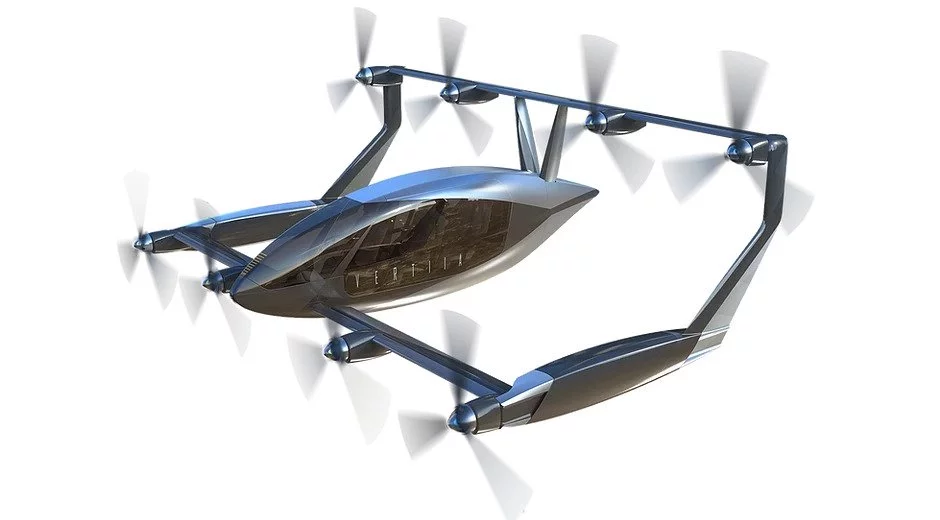The eVTOL space as a whole is definitely starting to look distinctly grown-up in 2023, transitioning from the crazy rush of concepts and ideas a few years ago into a broadly careful, measured and sensible sort of sector that's going through the exhaustive process of getting these machines ready for certification and manufacture.
Still, AMSL Aero is a unique and interesting company in this space – not only for the fact that it's working on this machine in Australia, on the opposite side of the globe from where most of the action is in China, Europe and the USA, but because the Vertiia is a very different airframe to the rest.
Its box wing formation should make it one of the most compact eVTOLs on the market, carrying up to five people with a footprint that might fit in a couple of car park spaces. And the Vertiia has been designed from the outset to run on hydrogen fuel cells – hence it boasts a ludicrous range figure, three to four times what most of the competition are claiming on batteries alone.

But Australia is enormous, bigger than the contiguous 48 states of the USA, with around one-thirteenth the population; if you want to build a useful air ambulance or regional commuter aircraft down under, you need to be able to handle some distance. And that could serve this company well in overseas markets too. "If you can solve the long range problem," co-founder Andrew Moore tells us over a video call, "short range is easy. If you only build a short range aircraft, then long range is impossible."
Moore believes the decision to design the Vertiia for a hydrogen powertrain from the ground up is a critical advantage, and that it'll be no easy task for competitors to redesign their aircraft to run on hydrogen, even once a powertrain is certified and ready for use. "It's almost a complete redesign if you haven't thought about it from the outset," he says.
Part of that is in keeping the hydrogen fuel outside the cabin – the Vertiia will store hydrogen in tanks connecting the ends of the wings. "One of the great advantages of the box wing," says Moore, "is that if you do it right, what you put in the wingtips actually helps you aerodynamically. So if you're putting underslung tanks under your wings, that'll give you a significant drag penalty – whereas for us, it can actually help us reduce drag."

The current prototype, which performed its first tethered flight tests in the first week of February, is fully battery-powered, and missing much of the sleek-looking bodywork that'll be seen on the production aircraft. Its footprint and wingspan are roughly the same as the eventual production plane will be, but the cabin is much smaller, big enough for two or three people riding tandem rather than five.
Work is currently in progress on the flight control system, and over the next couple of years, AMSL will expand the Vertiia's envelope. "We'll do lots of testing in a hover," says Moore, "then lots of testing at different wing tilt angles, and progress through into the transition envelope. In parallel with that, we'll continue to analyze the results from previous stages, and update and tweak and adjust."
AMSL has taken delivery of its first hydrogen fuel cell powertrain, and work is beginning on that side as well. "We've working to get that running," says Moore, "to improve our understanding of the limitations of integrating that into one of the prototype aircraft. We're also working closely with some companies that have some great expertise on hydrogen storage and hydrogen tanks as well. We're progressing towards some partnerships in that area."

After an AU$23 million (US$16 million) series B fundraising round in September last year, Moore says AMSL is "cashed up and ready to go, prepared for that next stage of development, but always looking for opportunities to accelerate. We've got very supportive investors right now, we're in a good place. What we're developing has an an immediate application – the air ambulance industry here buys and operates fixed-wing aircraft and helicopters to go rescue people from farms in the outback. What we'll provide is lower cost than what they currently use, but also provides a much better service with zero emissions and very flexible landing requirements. We know that we're building the right product, and that puts us in a great position. And when urban air mobility becomes a reality, once the supporting infrastructure and landing sites are in place, we'll be in a great place to take advantage of that."
Another potential advantage of working in Australia, says Moore, is that there really aren't a whole lot of other passenger aircraft working through the certification process with the local aviation authority, CASA. "CASA is very keenly involved," Moore tells us. "We have an ongoing and close engagement. CASA and the FAA have jointly certified aircraft in Australia before, so there's a well-trodden path to international certification. And as one of the few companies certifying in Australia, we'll be the number one focus, whereas the companies that are trying to certify in the US at the moment will be competing both with other urban air mobility companies and with existing industries that are certifying helicopters and airliners as well. From that standpoint, there are some positives. CASA isn't certifying lots of eVTOLs, but I think we can balance that with their very strong relationship with the FAA."
"There's an incredible amount of relief and joy in seeing the prototype get off the ground," says Moore. "It's a great feeling. And very validating – it's a slightly different aircraft to everyone else's, so there's been some naysayers, and it's great to prove them wrong!"
The AMSL team will have a booth at the Avalon Airshow outside Melbourne next week.
Source: AMSL Aero







